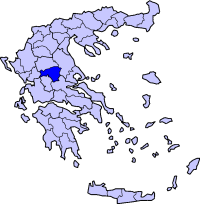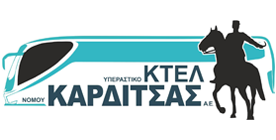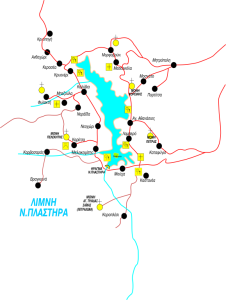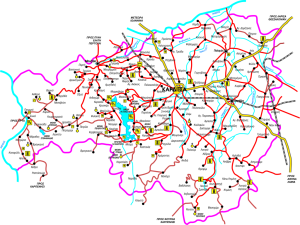 The Prefecture of Karditsa is one of the 51 prefectures of Greece and belongs geographically and administratively to the region of Thessaly.
The Prefecture of Karditsa is one of the 51 prefectures of Greece and belongs geographically and administratively to the region of Thessaly.
Specifically it is one of the four prefectures of Thessaly. It has an area of 2.576 sq. km. and a population of 129.541 inhabitants (2001 census).
The capital of the prefecture is the homonymous town of Karditsa with a population of 32.031 inhabitants.
In the Prefecture of Karditsa lies Lake Plastira, whose dam is about 50 kilometers from the city center of Karditsa. Georgios Karaiskakis, Charilaos Florakis and Archbishop Serafim were originated from the prefecture.
The city of Karditsa
Karditsa is a city of Greece, the capital of the Prefecture of Karditsa, formerly Prefecture of Thessaliotida, in Thessaly. At the 2001 census, the municipal district of Karditsa had a population of 32.252 inhabitants. In 1950 its population was about 14.000 inhabitants.
It is located almost in the middle of the plain of Thessaly and is built on a tributary of Pinios, also called the “river of Karditsa”. The city was inhabited during Ottoman domination; its name, although many consider it as Slavic, is Greek, from the word “karyditsa”, in the particular form of the new Thessalian idiom.
The city is famous for its good street layout, since it is a lowland area, the many pedestrian streets and the first bicycle path network. The wonderful grove “Pafsilypo” is located in the centre of the city, hosting free peacocks, with the historic metropolitan church of the Holy Emperors Constantine and Helen dominating at its end. At the western end of the grove the equestrian statue of Nikolaos Plastiras has been erected. The forest of Paparantza (Thousand Trees) is also located near the city, where we find the chapel of Prophet Elias.
Administrative division
Karditsa is the largest municipal district and the seat of the municipality of Karditsa, which had a population of 37.768 inhabitants during the 2001 census. The municipality includes the municipalities of Agiopigi, Artesianos, Karditsa, Karditsomagoula, Paleoklisi and Roussos.
Population
The predominant population element of the Thessalian plain and mainly of the lowland area of the prefecture (which constitutes the 49% of its total area) are the Karagounides. They are considered to be the direct descendants of the first inhabitants of the region since approximately 3000 years. The etymology of the word Karagounis presents difficulties. A first explanation indicates that the first combining form (kara-), of Turkish origin, refers to the black color, while the second (-goun) maybe to gouna (processed animal skin), or to the Turkish yunnan (Greeks), or, according to others, black fur or black gender in the sense of terrible. Another interpretive effort, more or less well founded, is related to the Greek kara (head) + the verb kouno (move) (since karagounides used instead of the affirmative answer yes to wow their heads). They are considered to be frugal people, good hikers and horsemen, and particularly hard to adverse conditions due to the continental climate of the region. Their straightforward behavior and hospitality are also known. Finally, their folk tradition is great and their customs equally characteristic.
History
Karditsa is the most newly built of the other three Thessalian capitals, although the prefecture has been inhabited since the beginning of the Paleolithic era. Its name very probably derived from the fact that it is situated in the heart – the middle of Greece and of the Thessalian plain. The first reference to the settlement is made by the English traveler Leake in 1810, while it will officially become a municipality in 1882, a year after its liberation from the Turks. On 12 March 1943 Karditsa becomes the first free city in Europe with the help of the ELAS fighters, while during the period of resistance an allied airport operated on the plateau of today’s Lake Plastira.
The Battle of Karditsa
One of the bloody battles of the civil war occurred in Karditsa, in December 1948, when powerful Democratic Army forces attacked the city. Specifically, the 1st and 2nd division of the Democratic Army as well as a cavalry brigade under Kostas Karagiorgis, gathered on the night of 11th to 12th December in a mountainous area west of Karditsa and moved towards Karditsa. From the afternoon of December 11th, several guerrillas of the Democratic Army had entered the city as peaceful citizens. For the safety of Karditsa, a force of 600 men with artillery and about 90 armed gendarmes had been made available, who were allocated to outside guardhouses and to some resistance centers inside the city.
The force of the Democratic Army, after having previously interrupted by various detachments the transportation to Karditsa, by blasting bridges and isolating the Greek Army guardhouses in order to obstruct any support, attacked the outside guardhouses, where it succeeded, because of its supremacy, to occupy them. In one of the guardhouses all soldiers thereof were killed, along with their officer. Subsequently, the guerillas, after entering the city, began an “unprecedented looting, murders, house burning and kidnappings of hostages”, while they were continuing the attack against those defending at the various resistance centers.
When the 2nd Army Corps was alerted by radio, a powerful force was sent with tanks, which arrived on the afternoon of the same day, that is on December 12th. There followed street battles in the city that lasted until the afternoon of December 13th, when the persecuted guerrillas left the city.
During the battle, the service offered by the scouts of Karditsa and other young people has been important. About 50 killed from among the civilian population were counted, while about 500 persons were abducted as hostages. There have been 19 killed and 85 wounded from among the forces of the National Army.
Sights
To the west, at the end of the city’s main pedestrian street, we find the neoclassical hotel Arni, built by a French architect in 1920, with a vaulted dome. To the south of the central square, at a small distance, it is located the impressive building of the Municipal Market, perhaps the only remaining building of the architectural style known as the “Modern Movement” based on the Hellenistic and Roman period. It functions as an area of culture (hosting exhibitions and presentations), entertainment and as a shopping center. Valvi Street, which leads to the market, is a street that retains the color of old Karditsa.
At a central spot of the city, next to Plastira Square, it is located the Pafsilypos grove, whose name derives from the fact that walking in it causes a “pause of sorrow”. Next to the park we find the 19th century Metropolitan Church of St. Constantine (one of the largest in Greece). It is decorated with frescoes by the well-known painter from Karditsa Dimitrios Gioldasis. The “unintentional German bomb”, which never exploded, miraculously protecting the magnificent dome of the Church, is overhung in the entrance thereof.
Lambros and Nafsika Sakellariou Folklore Museum, hosting personal objects of Nikolaos Plastiras, karaguna costumes, jewelery and accessories of folk costumes is located very close. North of the Metropolis, at a short distance, the 19th-century Temple of Zoodochos Pigi (Kaminadon District) is interesting its the wood-carved icon screen.
At the end of the central pedestrian street, leaving Pafsilypo grove, we find the central square, characterized by the building of Credit Bank, the old “Pallas”, a neoclassical building, built in the late 19th century, which functioned as a hotel and subsequently as a cinema. A reference point is the Fountain, which is a recent gem for the square and depicts at its ends the constellations at every point of the horizon.
Other important buildings are the Judicial Building, the renovated building of the Diocese and the stone building of the National Bank.
Plastira Lake
Plastira Lake is a lake located on the plateau of Nevropoli in the Prefecture of Karditsa. It is an artificial lake, officially called Tavropos Lake. It was formed in 1959, upon completion of the dam on the river Tavropos or Megdovas, and the idea for its construction was attributed to the military and politician Nikolaos Plastiras, who, in 1935, in a visit to his hometown, when catastrophic floods had occurred in the region and in Macedonia due to the continuous rainfalls, seeing the area allegedly said “one day there will be a lake here”; thus its more well-known name.
It was financed from money that Italy owed to Greece and the construction was undertaken by a French company. Today, the Public Power Corporation is managing the dam. We should note that prior to the construction of the lake, there was an airport on the plateau, where the first allied plane landed in Greece.
It contains 400 million cubic meters of water, it has a maximum length of 12 km, a maximum width of 4 km, its total surface is 24 square kilometers while its maximum depth is about 60 meters. Its water is used for irrigation and power generation, as there is also a 400 MW hydroelectric plant in the village of Mitropolis. In recent years it has also been exploited for tourist purposes, with several activities on and around the lake.




